Hemant Purohit
Exposing LLM Vulnerabilities: Adversarial Scam Detection and Performance
Dec 01, 2024



Abstract:Can we trust Large Language Models (LLMs) to accurately predict scam? This paper investigates the vulnerabilities of LLMs when facing adversarial scam messages for the task of scam detection. We addressed this issue by creating a comprehensive dataset with fine-grained labels of scam messages, including both original and adversarial scam messages. The dataset extended traditional binary classes for the scam detection task into more nuanced scam types. Our analysis showed how adversarial examples took advantage of vulnerabilities of a LLM, leading to high misclassification rate. We evaluated the performance of LLMs on these adversarial scam messages and proposed strategies to improve their robustness.
ORIS: Online Active Learning Using Reinforcement Learning-based Inclusive Sampling for Robust Streaming Analytics System
Nov 27, 2024



Abstract:Effective labeled data collection plays a critical role in developing and fine-tuning robust streaming analytics systems. However, continuously labeling documents to filter relevant information poses significant challenges like limited labeling budget or lack of high-quality labels. There is a need for efficient human-in-the-loop machine learning (HITL-ML) design to improve streaming analytics systems. One particular HITL- ML approach is online active learning, which involves iteratively selecting a small set of the most informative documents for labeling to enhance the ML model performance. The performance of such algorithms can get affected due to human errors in labeling. To address these challenges, we propose ORIS, a method to perform Online active learning using Reinforcement learning-based Inclusive Sampling of documents for labeling. ORIS aims to create a novel Deep Q-Network-based strategy to sample incoming documents that minimize human errors in labeling and enhance the ML model performance. We evaluate the ORIS method on emotion recognition tasks, and it outperforms traditional baselines in terms of both human labeling performance and the ML model performance.
Designing Decision Support Systems for Emergency Response: Challenges and Opportunities
Mar 13, 2022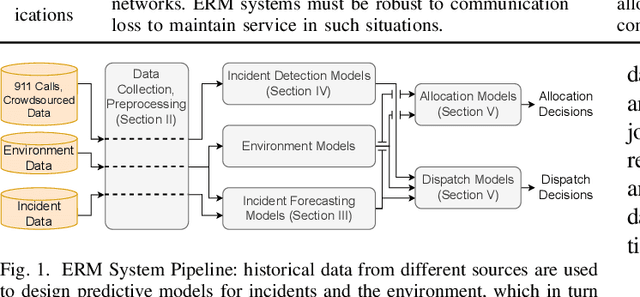

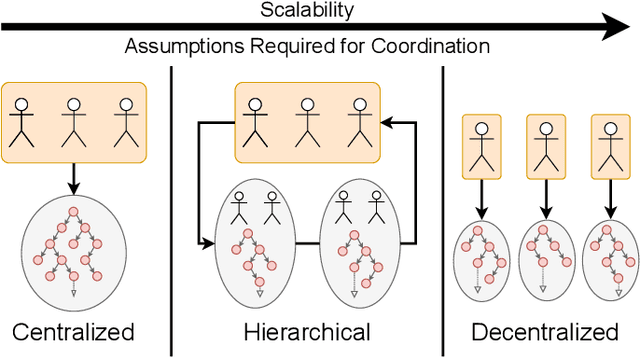
Abstract:Designing effective emergency response management (ERM) systems to respond to incidents such as road accidents is a major problem faced by communities. In addition to responding to frequent incidents each day (about 240 million emergency medical services calls and over 5 million road accidents in the US each year), these systems also support response during natural hazards. Recently, there has been a consistent interest in building decision support and optimization tools that can help emergency responders provide more efficient and effective response. This includes a number of principled subsystems that implement early incident detection, incident likelihood forecasting and strategic resource allocation and dispatch policies. In this paper, we highlight the key challenges and provide an overview of the approach developed by our team in collaboration with our community partners.
Practitioner-Centric Approach for Early Incident Detection Using Crowdsourced Data for Emergency Services
Dec 03, 2021



Abstract:Emergency response is highly dependent on the time of incident reporting. Unfortunately, the traditional approach to receiving incident reports (e.g., calling 911 in the USA) has time delays. Crowdsourcing platforms such as Waze provide an opportunity for early identification of incidents. However, detecting incidents from crowdsourced data streams is difficult due to the challenges of noise and uncertainty associated with such data. Further, simply optimizing over detection accuracy can compromise spatial-temporal localization of the inference, thereby making such approaches infeasible for real-world deployment. This paper presents a novel problem formulation and solution approach for practitioner-centered incident detection using crowdsourced data by using emergency response management as a case-study. The proposed approach CROME (Crowdsourced Multi-objective Event Detection) quantifies the relationship between the performance metrics of incident classification (e.g., F1 score) and the requirements of model practitioners (e.g., 1 km. radius for incident detection). First, we show how crowdsourced reports, ground-truth historical data, and other relevant determinants such as traffic and weather can be used together in a Convolutional Neural Network (CNN) architecture for early detection of emergency incidents. Then, we use a Pareto optimization-based approach to optimize the output of the CNN in tandem with practitioner-centric parameters to balance detection accuracy and spatial-temporal localization. Finally, we demonstrate the applicability of this approach using crowdsourced data from Waze and traffic accident reports from Nashville, TN, USA. Our experiments demonstrate that the proposed approach outperforms existing approaches in incident detection while simultaneously optimizing the needs for real-world deployment and usability.
Cross-Lingual Text Classification of Transliterated Hindi and Malayalam
Aug 31, 2021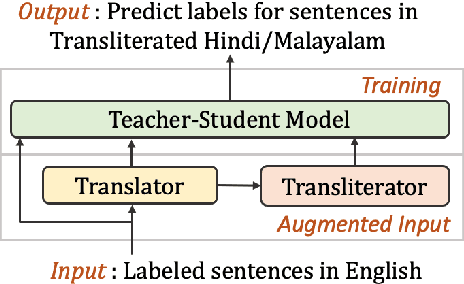
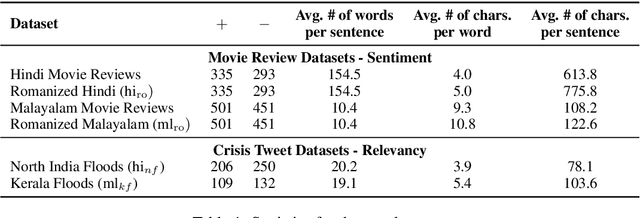

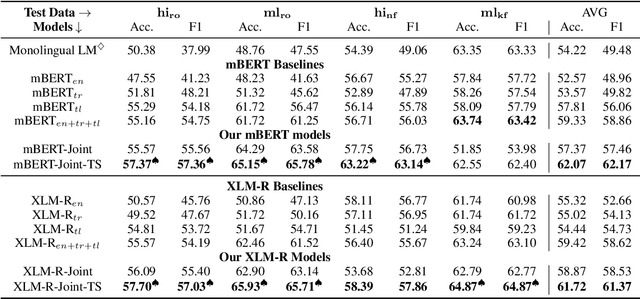
Abstract:Transliteration is very common on social media, but transliterated text is not adequately handled by modern neural models for various NLP tasks. In this work, we combine data augmentation approaches with a Teacher-Student training scheme to address this issue in a cross-lingual transfer setting for fine-tuning state-of-the-art pre-trained multilingual language models such as mBERT and XLM-R. We evaluate our method on transliterated Hindi and Malayalam, also introducing new datasets for benchmarking on real-world scenarios: one on sentiment classification in transliterated Malayalam, and another on crisis tweet classification in transliterated Hindi and Malayalam (related to the 2013 North India and 2018 Kerala floods). Our method yielded an average improvement of +5.6% on mBERT and +4.7% on XLM-R in F1 scores over their strong baselines.
Multilingual Code-Switching for Zero-Shot Cross-Lingual Intent Prediction and Slot Filling
Mar 16, 2021



Abstract:Predicting user intent and detecting the corresponding slots from text are two key problems in Natural Language Understanding (NLU). In the context of zero-shot learning, this task is typically approached by either using representations from pre-trained multilingual transformers such as mBERT, or by machine translating the source data into the known target language and then fine-tuning. Our work focuses on a particular scenario where the target language is unknown during training. To this goal, we propose a novel method to augment the monolingual source data using multilingual code-switching via random translations to enhance a transformer's language neutrality when fine-tuning it for a downstream task. This method also helps discover novel insights on how code-switching with different language families around the world impact the performance on the target language. Experiments on the benchmark dataset of MultiATIS++ yielded an average improvement of +4.2% in accuracy for intent task and +1.8% in F1 for slot task using our method over the state-of-the-art across 8 different languages. Furthermore, we present an application of our method for crisis informatics using a new human-annotated tweet dataset of slot filling in English and Haitian Creole, collected during Haiti earthquake disaster.
Emergency Incident Detection from Crowdsourced Waze Data using Bayesian Information Fusion
Nov 10, 2020



Abstract:The number of emergencies have increased over the years with the growth in urbanization. This pattern has overwhelmed the emergency services with limited resources and demands the optimization of response processes. It is partly due to traditional `reactive' approach of emergency services to collect data about incidents, where a source initiates a call to the emergency number (e.g., 911 in U.S.), delaying and limiting the potentially optimal response. Crowdsourcing platforms such as Waze provides an opportunity to develop a rapid, `proactive' approach to collect data about incidents through crowd-generated observational reports. However, the reliability of reporting sources and spatio-temporal uncertainty of the reported incidents challenge the design of such a proactive approach. Thus, this paper presents a novel method for emergency incident detection using noisy crowdsourced Waze data. We propose a principled computational framework based on Bayesian theory to model the uncertainty in the reliability of crowd-generated reports and their integration across space and time to detect incidents. Extensive experiments using data collected from Waze and the official reported incidents in Nashville, Tenessee in the U.S. show our method can outperform strong baselines for both F1-score and AUC. The application of this work provides an extensible framework to incorporate different noisy data sources for proactive incident detection to improve and optimize emergency response operations in our communities.
Common-Knowledge Concept Recognition for SEVA
Mar 26, 2020
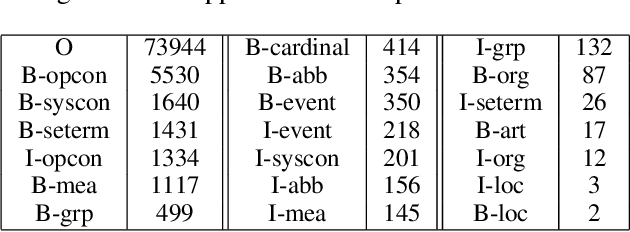
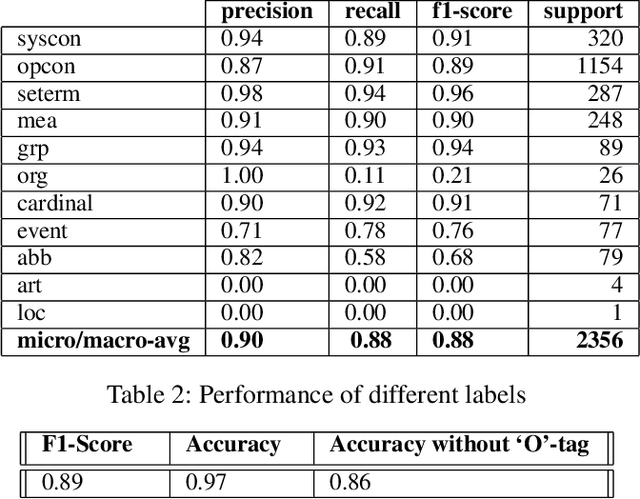

Abstract:We build a common-knowledge concept recognition system for a Systems Engineer's Virtual Assistant (SEVA) which can be used for downstream tasks such as relation extraction, knowledge graph construction, and question-answering. The problem is formulated as a token classification task similar to named entity extraction. With the help of a domain expert and text processing methods, we construct a dataset annotated at the word-level by carefully defining a labelling scheme to train a sequence model to recognize systems engineering concepts. We use a pre-trained language model and fine-tune it with the labeled dataset of concepts. In addition, we also create some essential datasets for information such as abbreviations and definitions from the systems engineering domain. Finally, we construct a simple knowledge graph using these extracted concepts along with some hyponym relations.
Unsupervised and Interpretable Domain Adaptation to Rapidly Filter Social Web Data for Emergency Services
Mar 04, 2020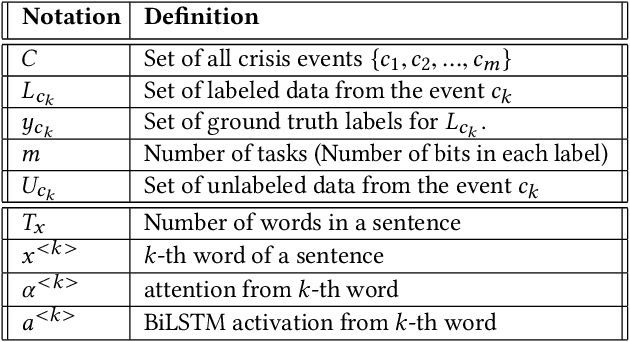
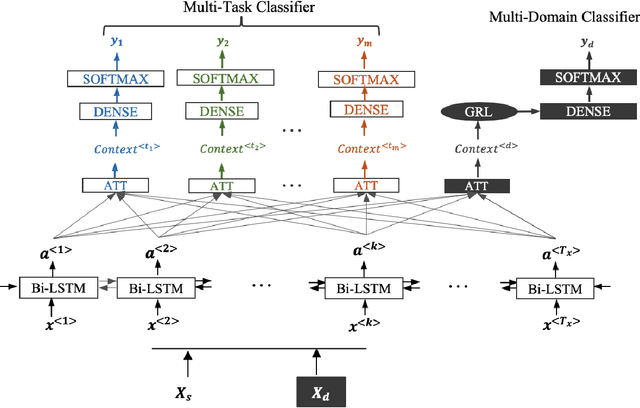
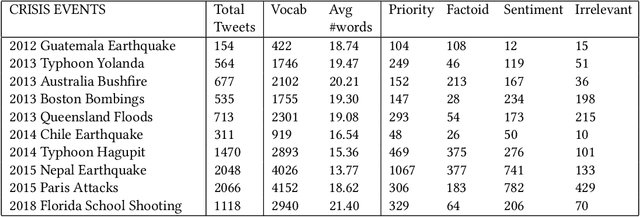

Abstract:During the onset of a disaster event, filtering relevant information from the social web data is challenging due to its sparse availability and practical limitations in labeling datasets of an ongoing crisis. In this paper, we show that unsupervised domain adaptation through multi-task learning can be a useful framework to leverage data from past crisis events, as well as exploit additional web resources for training efficient information filtering models during an ongoing crisis. We present a novel method to classify relevant tweets during an ongoing crisis without seeing any new examples, using the publicly available dataset of TREC incident streams that provides labeled tweets with 4 relevant classes across 10 different crisis events. Additionally, our method addresses a crucial but missing component from current research in web science for crisis data filtering models: interpretability. Specifically, we first identify a standard single-task attention-based neural network architecture and then construct a customized multi-task architecture for the crisis domain: Multi-Task Domain Adversarial Attention Network. This model consists of dedicated attention layers for each task and a domain classifier for gradient reversal. Evaluation of domain adaptation for crisis events is performed by choosing a target event as the test set and training on the rest. Our results show that the multi-task model outperformed its single-task counterpart and also, training with additional web-resources showed further performance boost. Furthermore, we show that the attention layer can be used as a guide to explain the model predictions by showcasing the words in a tweet that are deemed important in the classification process. Our research aims to pave the way towards a fully unsupervised and interpretable domain adaptation of low-resource crisis web data to aid emergency responders quickly and effectively.
Diversity-Based Generalization for Neural Unsupervised Text Classification under Domain Shift
Feb 25, 2020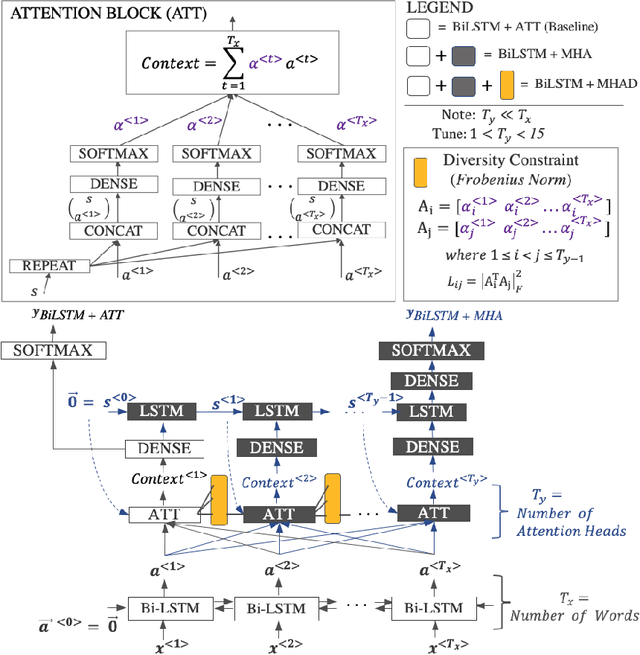



Abstract:Domain adaptation approaches seek to learn from a source domain and generalize it to an unseen target domain. At present, the state-of-the-art domain adaptation approaches for subjective text classification problems are semi-supervised; and use unlabeled target data along with labeled source data. In this paper, we propose a novel method for domain adaptation of single-task text classification problems based on a simple but effective idea of diversity-based generalization that does not require unlabeled target data. Diversity plays the role of promoting the model to better generalize and be indiscriminate towards domain shift by forcing the model not to rely on same features for prediction. We apply this concept on the most explainable component of neural networks, the attention layer. To generate sufficient diversity, we create a multi-head attention model and infuse a diversity constraint between the attention heads such that each head will learn differently. We further expand upon our model by tri-training and designing a procedure with an additional diversity constraint between the attention heads of the tri-trained classifiers. Extensive evaluation using the standard benchmark dataset of Amazon reviews and a newly constructed dataset of Crisis events shows that our fully unsupervised method matches with the competing semi-supervised baselines. Our results demonstrate that machine learning architectures that ensure sufficient diversity can generalize better; encouraging future research to design ubiquitously usable learning models without using unlabeled target data.
 Add to Chrome
Add to Chrome Add to Firefox
Add to Firefox Add to Edge
Add to Edge